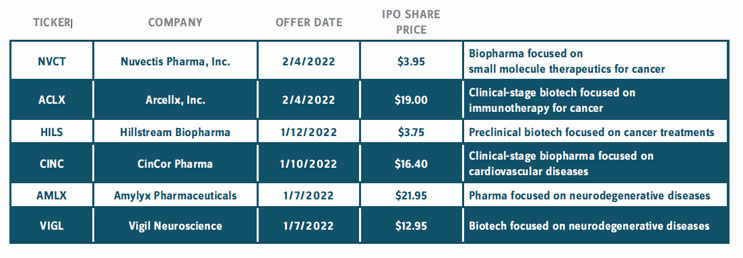Key Considerations In Early-Stage Biopharma Financing
By Richard Ramko, EY

After over two years of soaring IPO valuations and high stock prices, biotech had a reckoning in the back half of 2021. But while the industry is clearly facing headwinds, there’s significant cause for optimism for early-stage biotechs looking for funding, not the least of which is 2021’s high levels of venture capital fund formation. Further, Big Pharma and biotech alike are sitting on near-record levels of firepower — the capacity for deal-making based on the strength of the balance sheet.
The pandemic created a perfect storm for biotech IPOs. Seemingly all at once, we witnessed mRNA technology coming of age with the advent of COVID-19 vaccines, against a backdrop of high liquidity and investors rushing to get their money into SPACs. As COVID-19 spurred demand for pharmaceuticals, other sectors stalled due to the general economic slowdown. Indeed, the lack of competition made the fast-growing biotech sector the best place and one of the only places, to put money into. New investors and funding sources making larger-scale bets flooded the industry with unprecedented levels of capital.
With the pandemic on the wane in the early months of 2022, sectors are coming back to life as pharma, particularly biotech, faces challenges on multiple fronts, most obviously regarding the troubled IPO and SPAC market. In this article, we will assess the current early-stage financing landscape and explore capital trends across the sector.
Current State of Biotech Public Offerings
In 2020 and 2021, the public offerings for biotech startups pulled in $30 billion, tripling the biotech IPO total from 2018 and 2019. Even before biotech faced increased regulatory pressure, many newly public biotech ventures were months or years away from clinical trials with their core offerings, and it became evident that the market capitalization greatly exceeded actual value.
More than half of the companies that went public in 2021 traded below their offering prices midway through the year and in the early months of 2022, IPOs are becoming increasingly scarce as the SPAC boom that fueled biotech IPO mania sputters down to earth. After wildly overperforming during the pandemic, SPAC returns bottomed out in late 2021 and early 2022, with more than 300 SPACs facing investor- die deadlines. The Nasdaq’s biotechnology index, representing 213 biotech companies, has lost over 20 percent in value since August 2021, despite buoyancy from Moderna and several other high-fliers.
While the market for biotech softened in the back half of 2021, and despite high-profile losses in the SPAC and IPO markets, early-stage biotech startups still have access to historic levels of capital due to the growing diversification of early-stage funding. The IPO has never been the sole source of funding for biotech, and that is especially true today, as the dip in public funding is more than offset by private financing sources. Private equity, corporate venture, family offices, and collaboration agreements, and even private equity firms, are eager to put money into earlier-stage biotech companies.
While the level of investment dollars enjoyed by the biotech industry during the pandemic is gone, the demand for biotech to continue producing innovative treatments and technologies is higher than ever. And with biotech on the cusp of industry-transforming technological innovation, it’s reasonable to expect that demand for biotech will increase even further.
2022 Biotech/Pharma IPOs
The following are some of the biotech and pharma companies that have gone public in January and February of 2022

SOURCE: Yahoo Finance
Pharma's Pipeline Needs Drive Biotech Capital Activity
As the 40-year-old biotech industry reaches maturity, the already-unprecedented rate of innovation present in today’s landscape will accelerate further. Long-in-development technologies, like mRNA and cell and gene therapies, have been proven to work or will soon come to fruition. With their ability to not just treat, but to cure, diseases, mRNA and cell and gene therapies are likely to dramatically expand the possibilities and demand for healthcare.
Big Pharma’s need for a strong pipeline remains in place. For a long time, that innovation has come from collaboration agreements with biotech companies or acquisition of biotech companies, as most leading biopharmas are not pushing to bring such capabilities in-house. Bigger biopharma companies will need external innovation to stay competitive, but those transactions won’t necessarily be acquisitions.
As many innovative smaller companies remain well-capitalized, M&A proposals may not appeal. Because of the tendency for seller expectations to lag the market, if they do set an asking price, it will likely be higher than prospective acquirers are willing to pay. And prospective buyers have good reason to be cautious with acquisitions, as partnerships and alliances with startups have offered greater benefits. Since the beginning of 2020, major biopharmas have deployed roughly 1.5 times more capital firepower on alliances relative to M&A and have seen greater return on investment from licensing and collaboration agreements, corporate venture investments, or direct equity arrangements than M&A.
Biotech Financing In 2022
It’s reasonable to expect that a fair share of the companies that went public in 2020 and 2021 may have negative data. And given where the public markets are, and where we think they’ll be over the next year, the negative data may hinder their ability to raise additional funds. This could compel those startups to either find creative means of acquiring additional capital or become M&A candidates, particularly if they’ve got a platform of products that are underutilized or undervalued by the markets. But, despite those individual companies falling short of their capitalization needs, the record amount of venture capital fund formation and increasing investment by private equity firms means that they will likely be the exception rather than the rule for early-stage biotech funding.
While public company financing for biotech companies has plummeted and is likely to stay low for the foreseeable future, funding remains strong overall, thanks to continuing robust private financing, with more venture capital being raised than ever and corporate VC funds and partnering deals at record levels. In light of today’s diverse options for early-stage funding and a foreseeable increase in demand for biotech as long-in-development technologies come of age, it’s a great time to be in the biotech sector.
The views reflected in this article are those of the author and do not necessarily reflect the views of the global EY organization or its member firms.
 About The Author:
About The Author:
Richard Ramko is the life sciences assurance leader for the EY U.S.-West region. In this role, he counsels biotech, medtech, and pharmaceutical clients on financial, business, operational, governance, and strategic matters.
